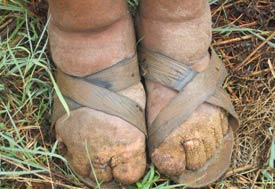Genetic link discovered in tropical foot disease
May / June 2012 | Volume 11, Issue 3

Photo courtesy of Dr. Fasil Ayel, NHGRI/NIH
NIH scientists have discovered a genetic link
to podoconiosis, a disease that causes swelling
and disfigurement in some people, after
extended exposure to volcanic soil.
A genetic variant makes some people more likely to develop podoconiosis, a tropical disease that causes foot and leg disfigurement, according to a recent study. Researchers identified four genes associated with the disease, which is triggered by walking barefoot on red clay soil that contains microscopic mineral shards from volcanoes. These shards penetrate the feet and - only in some people but often within families - induce an immune reaction of inflammation and painful, spreading lumps.
Identifying who has these genes and is therefore at elevated risk should accelerate preventive and treatment measures, the scientists said. Their study, published in the New England Journal of Medicine, was supported in part by the Wellcome Trust and the NIH's National Human Genome Research Institute (NHGRI).
Podoconiosis, also known as non-filarial elephantiasis, was recently designated a neglected tropical disease by the World Health Organization (WHO). Its victims develop swelling in their feet, ankles and eventually legs. Along with the disfigurement comes social stigma and economic consequences. The only known way to prevent podoconiosis is to wear closed shoes from early childhood.
The researchers studied a population in a high-prevalence area in rural Ethiopia, where they estimated that siblings of an affected person were five times more likely to develop symptoms than people in the general population. The team collected saliva samples from 194 patients and from 203 controls—healthy members of families with podoconiosis cases and individuals from the general population—and conducted genomic association tests.
The four genetic variants found to be associated with podoconiosis are in a class of genes involved in T-cell-mediated inflammation. In this particular disease, mineral particles rather than pathogens might trigger the chain of responses. Immune cells in the lower limb lymphatic system engulf the shards, triggering inflammation, which is followed by fibrosis and obstruction of the vessels.
NIH researchers included Drs. Fasil Tekola Ayele, Charles N. Rotimi and Adebowale A. Adeyemo, all at NHGRI’s Center for Research on Genomics and Global Health.
The authors said their study provides a research model for other fibrosing diseases, such as filariasis and pneumoconiosis, and for complex gene-environment inflammatory diseases, which are often poorly understood. They added that studies of podoconiosis patients in other parts of the world might reveal additional genes involved in disease susceptibility.
"This is an excellent example of how genomics can further our understanding on how to prevent terrible diseases that have a genetic basis," Rotimi said. "Through our H3Africa initiative, we hope to build capacity in genomics throughout Africa so that scientists can discover genetic links for other diseases."
Human Heredity and Health in Africa (H3Africa) aims to enhance the ability of African scientists to use cutting-edge research approaches to study the genes and environment behind common diseases and, ultimately, to improve health in African populations. H3Africa is supported by the NIH Common Fund and the U.K.-based Wellcome Trust. The first grants are expected to be awarded later in 2012.
Podoconiosis prevalence
The World Health Organization (WHO) says Ethiopia has the highest prevalence of podoconiosis, with an estimated 1 million of the world’s 4 million cases, followed by Cameroon, with 500,000. The disease occurs in several other African countries, Central and South America, and India. In populations where the soil contains irritant shards, the prevalence is 5 to 10 percent, according to the WHO.
The economic consequences of lost work days are severe, for instance costing Ethiopia more than $200 million annually. The disease can be avoided by wearing shoes consistently from a young age. Other preventive steps include washing feet daily with soap, using moisturizer, raising the legs and doing specific exercises. If swelling develops, compression bandages provide relief, the WHO says.
More Information
To view Adobe PDF files,
download current, free accessible plug-ins from Adobe's website.